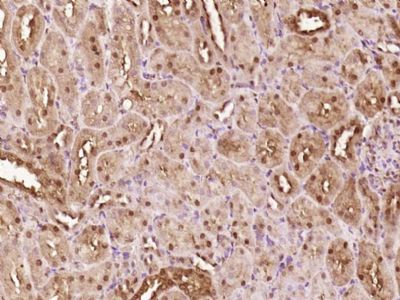ATBF1 Polyclonal Antibody
Purified Rabbit Polyclonal Antibody (Pab)
- SPECIFICATION
- CITATIONS
- PROTOCOLS
- BACKGROUND

Application
| IHC-P, IHC-F, IF, ICC, E |
|---|---|
| Primary Accession | Q15911 |
| Reactivity | Rat, Dog, Bovine |
| Host | Rabbit |
| Clonality | Polyclonal |
| Calculated MW | 404 KDa |
| Physical State | Liquid |
| Immunogen | KLH conjugated synthetic peptide derived from human ATBF1 |
| Epitope Specificity | 301-400/3703 |
| Isotype | IgG |
| Purity | affinity purified by Protein A |
| Buffer | 0.01M TBS (pH7.4) with 1% BSA, 0.02% Proclin300 and 50% Glycerol. |
| SUBCELLULAR LOCATION | Nuclear |
| SIMILARITY | Contains 22 C2H2-type zinc fingers. Contains 4 homeobox DNA-binding domains. |
| SUBUNIT | Interacts with FNBP3 (By similarity). Interacts with PIAS3. |
| Post-translational modifications | Phosphorylated upon DNA damage, probably by ATM or ATR. |
| Important Note | This product as supplied is intended for research use only, not for use in human, therapeutic or diagnostic applications. |
| Background Descriptions | AT-motif binding factor 1 (ATBF1) binds to the AT-rich core sequence element in the human a-fetoprotein enhancer (1). Alternative splicing generates the ATBF1-A and ATBF1-B (2,3). While ATBF1-A contains a 920-amino acid extension at the N-terminus, both ATBF1-A and ATBF1-B contain 4 DNA-binding homeobox domains (2,3). Additionally, ATBF1-A contains 23 zinc finger motifs while ATBF1-B contains 18 zinc finger motifs (1–3). The N-terminal extension unique to ATBF1-A has transcriptional repressor activity (4). In the small intestine, ATBF1-A inhibits expression of the brushborder enzyme aminopeptidase-N through direct binding to the AT motif element (5). Besides functioning in transcription regulation, ATBF1 also functions in ATPase activity (6). ATPase activity associated with ATBF1-A is DNA/RNA-dependent and requires both homeobox domains and zinc finger motifs (6). ATBF1 is highly expressed in spleen and brain tissues (7). The gene encoding human ATBF1 maps to chromosome 16q22.3-q23.1 (8). |
| Gene ID | 463 |
|---|---|
| Other Names | Zinc finger homeobox protein 3, AT motif-binding factor 1, AT-binding transcription factor 1, Alpha-fetoprotein enhancer-binding protein, Zinc finger homeodomain protein 3, ZFH-3, ZFHX3, ATBF1, C16orf47 {ECO:0000312|HGNC:HGNC:777} |
| Target/Specificity | Not found in normal gastric mucosa but found in gastric carcinoma cells (at protein level). |
| Dilution | IHC-P=1:100-500,IHC-F=1:100-500,ICC=1:100-500,IF=1:100-500,ELISA=1:5000-10000 |
| Storage | Store at -20 ℃ for one year. Avoid repeated freeze/thaw cycles. When reconstituted in sterile pH 7.4 0.01M PBS or diluent of antibody the antibody is stable for at least two weeks at 2-4 ℃. |
| Name | ZFHX3 |
|---|---|
| Synonyms | ATBF1, C16orf47 {ECO:0000312|HGNC:HGNC:7 |
| Function | Transcriptional regulator which can act as an activator or a repressor. Inhibits the enhancer element of the AFP gene by binding to its AT-rich core sequence. In concert with SMAD-dependent TGF-beta signaling can repress the transcription of AFP via its interaction with SMAD2/3 (PubMed:25105025). Regulates the circadian locomotor rhythms via transcriptional activation of neuropeptidergic genes which are essential for intercellular synchrony and rhythm amplitude in the suprachiasmatic nucleus (SCN) of the brain (By similarity). Regulator of myoblasts differentiation through the binding to the AT-rich sequence of MYF6 promoter and promoter repression (PubMed:11312261). Down-regulates the MUC5AC promoter in gastric cancer (PubMed:17330845). In association with RUNX3, up-regulates CDKN1A promoter activity following TGF-beta stimulation (PubMed:20599712). Inhibits estrogen receptor (ESR1) function by selectively competing with coactivator NCOA3 for binding to ESR1 in ESR1-positive breast cancer cells (PubMed:20720010). |
| Cellular Location | Nucleus. Cytoplasm Note=Translocates from the cytoplasm to the nucleus following TGF-beta stimulation. Expressed in nuclear body (NB)-like dots in the nucleus some of which overlap or closely associate with PML body |
| Tissue Location | Not found in normal gastric mucosa but found in gastric carcinoma cells (at protein level). Expression is higher in ER- positive breast tumors than ER-negative breast tumors (at protein level). |

Thousands of laboratories across the world have published research that depended on the performance of antibodies from Abcepta to advance their research. Check out links to articles that cite our products in major peer-reviewed journals, organized by research category.
info@abcepta.com, and receive a free "I Love Antibodies" mug.
Provided below are standard protocols that you may find useful for product applications.
If you have used an Abcepta product and would like to share how it has performed, please click on the "Submit Review" button and provide the requested information. Our staff will examine and post your review and contact you if needed.
If you have any additional inquiries please email technical services at tech@abcepta.com.













 Foundational characteristics of cancer include proliferation, angiogenesis, migration, evasion of apoptosis, and cellular immortality. Find key markers for these cellular processes and antibodies to detect them.
Foundational characteristics of cancer include proliferation, angiogenesis, migration, evasion of apoptosis, and cellular immortality. Find key markers for these cellular processes and antibodies to detect them. The SUMOplot™ Analysis Program predicts and scores sumoylation sites in your protein. SUMOylation is a post-translational modification involved in various cellular processes, such as nuclear-cytosolic transport, transcriptional regulation, apoptosis, protein stability, response to stress, and progression through the cell cycle.
The SUMOplot™ Analysis Program predicts and scores sumoylation sites in your protein. SUMOylation is a post-translational modification involved in various cellular processes, such as nuclear-cytosolic transport, transcriptional regulation, apoptosis, protein stability, response to stress, and progression through the cell cycle. The Autophagy Receptor Motif Plotter predicts and scores autophagy receptor binding sites in your protein. Identifying proteins connected to this pathway is critical to understanding the role of autophagy in physiological as well as pathological processes such as development, differentiation, neurodegenerative diseases, stress, infection, and cancer.
The Autophagy Receptor Motif Plotter predicts and scores autophagy receptor binding sites in your protein. Identifying proteins connected to this pathway is critical to understanding the role of autophagy in physiological as well as pathological processes such as development, differentiation, neurodegenerative diseases, stress, infection, and cancer.


